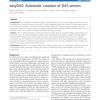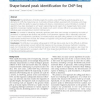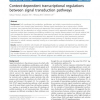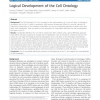BMCBI
2011
13 years 6 months ago
2011
Background: The Distributed Annotation System (DAS) has proven to be a successful way to publish and share biological data. Although there are more than 750 active registered serv...
BMCBI
2011
13 years 6 months ago
2011
Background: The identification of binding targets for proteins using ChIP-Seq has gained popularity as an alternative to ChIP-chip. Sequencing can, in principle, eliminate artifac...
BMCBI
2011
13 years 6 months ago
2011
Background: Building repositories of computational models of biological systems ensures that published models are available for both education and further research, and can provid...
BMCBI
2011
13 years 6 months ago
2011
Background: With continuing identification of novel structured noncoding RNAs, there is an increasing need to create schematic diagrams showing the consensus features of these mol...
BMCBI
2011
13 years 6 months ago
2011
Background: To characterize the diversity of bacterial populations in metagenomic studies, sequencing reads need to be accurately assigned to taxonomic units in a given reference ...
BMCBI
2011
13 years 6 months ago
2011
BMCBI
2011
13 years 6 months ago
2011
Background: We present a novel method to encode ambiguously aligned regions in fixed multiple sequence alignments by ‘Pairwise Identity and Cost Scores Ordination’ (PICS-Ord)....
BMCBI
2011
13 years 6 months ago
2011
Background: Cells coordinate their metabolism, proliferation, and cellular communication according to environmental cues through signal transduction. Because signal transduction h...
BMCBI
2011
13 years 6 months ago
2011
Background: The Cell Ontology (CL) is an ontology for the representation of in vivo cell types. As biological ontologies such as the CL grow in complexity, they become increasingl...
BMCBI
2011
13 years 6 months ago
2011
Background: The combination of genotypic and genome-wide expression data arising from segregating populations offers an unprecedented opportunity to model and dissect complex phen...





